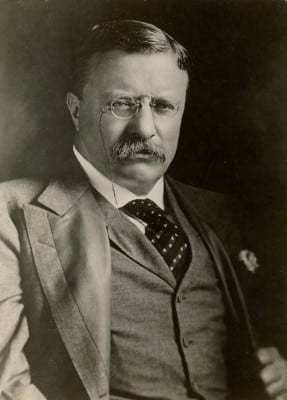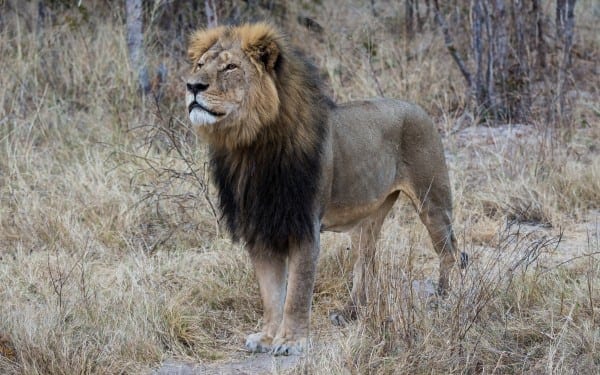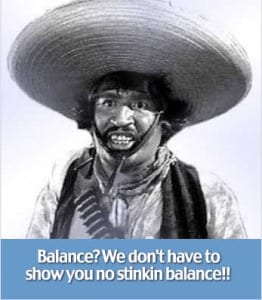No Refuge for Wildlife
[dropcap]T[/dropcap]he armed hunter-rancher occupation of the Malheur National Wildlife Refuge shows the need for the Federal Government to enforce wildlife protection laws. Unfortunately, wildlife refuges were designed from the outset to benefit hunters, not wildlife, in accordance with principles the Boone and Crockett Club developed a century ago.

The Ammon Bundy bunch: Big hats, small brains (and hearts). These libertarian militias—”extremist privatizers”— have long held nature and animals as their personal fief, to do as they please. And the Federal agencies’ corruption and equivocations and the perennial climate of deference to right-wingers among politicians and media whores has only fanned their audacity and sense of entitlement. It’s too bad that the sheer beauty of the great outdoors has been perverted to serve as almost poetic cover for an essentially squalid view of our place in the web of life.
Theodore Roosevelt, a notorious big game hunter, co-founded Boone and Crockett with George Bird Grinnell (who founded one of the first Audubon societies). Membership in the Boone and Crockett Club was originally restricted to men who had killed at least three different large species of American wildlife, including bear, bison, caribou, cougar, and moose. Malheur National Wildlife Refuge, which traces its origins to President Theodore Roosevelt, is one of 336 wildlife refuges (out of a total of 560) which allow hunting.
Among the early members of the Club were Aldo Leopold and Gifford Pinchot. In 1905 Roosevelt appointed Pinchot as the first Chief Forester of the U.S. Forest Service. After working for the U.S. Forest Service in New Mexico, Leopold developed Pinchot’s principles of scientific forest management into a new science of game management. In conjunction with the Boone & Crockett Club, the Wildlife Society certifies game managers as trademarked wildlife biologists in accordance with principles now called the North American Model of Wildlife Conservation.
One of the principles of the model is the so-called public trust doctrine. In its statement condemning the armed occupation of Malheur Wildlife Refuge, Portland Audubon stresses its acceptance of the public trust principle as part of its collaborationist strategy with hunters and ranchers:
In 2013, the Refuge adopted a long-term management plan developed through an inclusive collaborative process that brought together the local community, tribes, conservation groups, state and federal agencies, and other stakeholders. These stakeholders have continued to work together to implement this strategy which includes one of the biggest wetland restoration efforts ever undertaken.
The occupation of Malheur by armed, out of state militia groups puts one of America’s most important wildlife refuges at risk. It violates the most basic principles of the Public Trust Doctrine.

Capricious and self-indulgent, an avid hunter and adventurer, T.R.’s lifelong quest for macho reassurance led him to both support and exploit nature. For all the wrong reasons, he still casts a long shadow.
The public trust doctrine is a dubious legal principle formulated before the Civil War by Chief Justice Roger Taney, best known for his Dred Scott decision recognizing states’ rights to define slaves as property. Good old boys like the Bundy clan long for the good old days of the pre-Civil War US Constitution. The North American model applies Taney’s doctrine to wildlife, asserting that wildlife is state property.
The Federal government uses the public trust doctrine to open up National Wildlife Refuges to hunting under the control of state game departments. The US Fish and Wildlife Service sees Aldo Leopold as a model for hunting on wilderness areas and wildlife refuges. The current New Mexico Game and Fish Department is using the principle of state ownership of wildlife under the so-called public trust doctrine to prevent a private landowner, Ted Turner, from providing protection to wolves on his Ladder Ranch.
In fact, later Supreme Court decisions, besides overruling Dred Scott have taken a different approach to wildlife regulation, specifically applied to New Mexico. In Kleppe v. New Mexico, the Court stated: “We hold today that the Property Clause also gives Congress the power to protect wildlife on the public lands, state law notwithstanding.” Another principle of the North American Model, which environmental lobbyists cheerfully accept, is science-based decision making. Valerius Geist, who claims credit for coining the phrase North American Model of Wildlife Conservation to describe the principles of Aldo Leopold’s scientific game management, describes the model as follows:
It led to a new uniquely North American profession: the university trained wildlife biologist or manager. The first notable practitioner among these was Aldo Leopold. He rose to be an idol of not only wildlife biologists, but of the environmental movement at large with his inspiring writing. It insured that North America’s wildlife received well-qualified, professional attention and care in its conservation and management.
Geist references Leopold’s two main works, Game Management (1933) and A Sand County Almanac (1949). While few environmentalists are familiar with the earlier work, most are familiar with the later work, which includes the essay Thinking Like a Mountain. But few readers of this semi-fictional account of wolf killing realize that Leopold wrote it over three decades after he killed the wolf.
We reached the old wolf in time to watch a fierce green fire dying in her eyes. I realized then, and have known ever since, that there was something new to me in those eyes – something known only to her and to the mountain I was young then, and full of trigger-itch; I thought that because fewer wolves meant more deer, that no wolves would mean hunters’ paradise. But after seeing the green fire die, I sensed that neither the wolf nor the mountain agreed with such a view.
While the essay suggests he regretted that particular killing, the regret is apparently quite limited. Nowhere does Leopold say that there was anything wrong with his aim to maintain a “hunters’ paradise,” or even with his premise, “fewer wolves meant more deer.” He only has misgivings about hunting wolves to the point of extinction. Indeed this was the basis of his so-called science of game management, which he described in his 1933 book of that title as “the art of making land produce sustained annual crops of wild game for recreational use.” As his mentor Pinchot saw forests as a supply of trees to be harvested, Leopold saw wildlife as a resource for hunters to harvest.
In a Wildlife Society article titled An Inadequate Construct, Dr. Michael P. Nelson challenges the tenet of the North American Model which “asserts that Science is the Proper Tool for Discharge of Wildlife Policy.” Nelson states:
This is mistaken for equating a desire for policies informed by science with science discharging or determining, by itself, what policies ought to be adopted—a serious, but very common, error in ethical reasoning. Scientific facts about nature cannot, by themselves, determine how we ought to relate to nature or which policies are most appropriate.
Designating a species as endangered is, and always has been, a political classification, not a biological one. The demand for “science-based” wildlife policy, as called for in the ESA and interpreted by USFWS, is in fact a call for following the hunter-based wildlife management of the Boone & Crockett Club.

Cecil living his life. He was to meet an ignominious end at the hands of a moral idiot. African animals destinies have long been subject to the whim of EuroAmerican powers.
State game departments, who provide much of the data used by USFWS, also claim to be wildlife biologists. For example, New Mexico Game and Fish claims in its mission statement: “Our highly qualified biologists use the best science available to manage the state’s wildlife for more than 100,000 hunters and 800,000 outdoor enthusiasts to enjoy annually.” In spite of state game department’s efforts to support hunters, some still refuse to follow the regulations designed to help them continue their blood sports. Walter Palmer, for example, had a record of hunting violations in the US before he went off to Africa to murder Cecil the lion.
In response to the murder of Cecil the United States Fish and Wildlife Service (USFWS) has added African lions to the list of threatened and endangered species. American trophy hunters are directly responsible for slaughtering at least 5,647 lions in the last 10 years, according to import data HSUS mined from USFWS. The rule puts some restrictions on importing hunting trophies, but supports the idea that sport hunting is conservation.
The Service found that sport-hunting, if well managed, may provide a benefit to the subspecies. Well-managed conservation programs use trophy hunting revenues to sustain lion conservation, research and anti-poaching activities. However, the Service found that not all trophy hunting programs are scientifically based or managed in a sustainable way. So in addition to protecting both lion subspecies under the ESA, we created a permitting mechanism to support and strengthen the accountability of conservation programs in other nations. This rule will allow for the importation of the threatened Panthera leo melanochaita, including sport-hunted trophies, from countries with established conservation programs and well-managed lion populations.
The significant restriction on trophy hunting is the associated restriction on importing sport hunting. Had this rule been in effect (and enforced) a year ago, it would have prevented Walter Palmer, with a record of poaching violations, from importing African lion trophies.
The recently announced USFWS policy on African lions includes a prohibition on anyone with a poaching record from importing lion trophies, which, if enforced, could prove more effective than the 4(d) rule in protecting African lions from American hunters.
Concurrent with this final listing rule, to protect lions and other foreign and domestic wildlife from criminal activity, U.S. Fish and Wildlife Service Director Dan Ashe also issued a Director’s Order to strengthen enforcement of wildlife permitting requirements. Through the Director’s Order, the Service is redoubling its efforts to ensure that the world’s rarest species are protected from those who violate wildlife laws. The Service has the authority to deny future permit applications for activities such as sport hunted trophy imports to anyone that has previously been convicted of or pled guilty to violations of wildlife laws. The order will ensure that this authority will be exercised to the fullest extent.
Leopold’s followers today are looking for an expansion of the use of threatened status, with its limited protections under ESA section 4(d), as an alternative to full endangered species protections, as an alternative to full endangered species protections. While some environmentalist followers of Leopold have pushed the idea of threatened status for the grey wolf as a compromise alternative to full listing as an endangered species, the organization which has laid out this strategy most clearly is Mission:Wildlife a project of the Sand County Foundation, dedicated to the so-called land ethic Aldo Leopold described in his Sand County Almanac. Mission:Wildlife calls itself as “a new environmental organization advancing bold policies that will do more to restore endangered wildlife while reducing costs to communities and risks for businesses.”
ESA section 4(d) is the basis for the USFWS recently announced policy on limited protection for African lions. Just as it has used recent reclassification of grey wolf (Canis lupus ssp.) as an excuse to deny full endangered species protection, so it now uses a proposed reclassification of the lion(Panthera leo ssp.) to deny full endangered species protection for African lions. The use of recent studies by real biologists gives a scientific veneer to decisions that are actually based on proposals from game managers who describe themselves as wildlife biologists. Reclassifying African lions brings the North American model of conservation to Africa, an implicit connection personified by Teddy Roosevelt, big game hunter and co-founder of the Boone & Crockett Club.
Note to Commenters
Due to severe hacking attacks in the recent past that brought our site down for up to 11 days with considerable loss of circulation, we exercise extreme caution in the comments we publish, as the comment box has been one of the main arteries to inject malicious code. Because of that comments may not appear immediately, but rest assured that if you are a legitimate commenter your opinion will be published within 24 hours. If your comment fails to appear, and you wish to reach us directly, send us a mail at: editor@greanvillepost.com
We apologize for this inconvenience.
=SUBSCRIBE TODAY! NOTHING TO LOSE, EVERYTHING TO GAIN.=
free • safe • invaluable
[email-subscribers namefield=”YES” desc=”” group=”Public”]
Nauseated by the
vile corporate media?
Had enough of their lies, escapism,
omissions and relentless manipulation?
Send a donation to
The Greanville Post–or
But be sure to support YOUR media.
If you don’t, who will?


